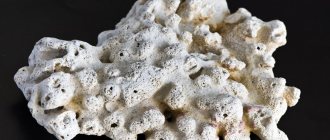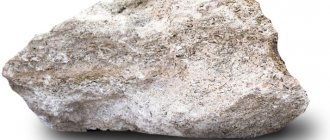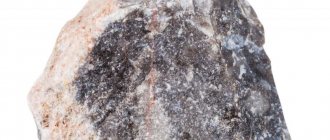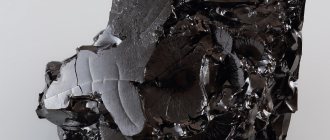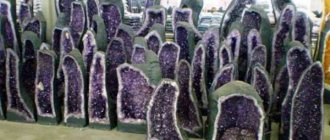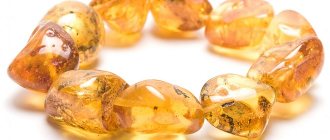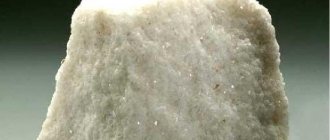Limestone is a natural stone of soft sedimentary rock of organic or organo-chemical origin. The main element that makes up limestone is calcium carbonate (calcite). In addition, limestone may also contain impurities of quartz, phosphate, silicon, clay, as well as sand particles, calcareous remains of microorganism skeletons.
Limestone rock
Limestone as a mineral, properties of limestone:
Limestone is a sedimentary, clastic rock of organic, less often chemogenic origin, consisting mainly of calcium carbonate (CaCO3) in the form of calcite crystals of various sizes. The composition of limestone includes various impurities; in some cases, individual shells are distinguishable and recognizable in the limestone.
Limestone is a mineral formed in the seas and oceans, as well as in freshwater bodies. Limestone deposits were formed in different geological eras. The formation of most limestones occurred and is currently occurring (for example, coral reefs) due to the extraction of calcium carbonate by living organisms from sea water to build shells and skeletons. The remains of dead living organisms settle and accumulate on the seabed. Calcium carbonate, precipitated from the water saturated with it, is added to the settled limestone debris on the seabed.
Rice. 1. Limestone
Limestone is a natural stone, known and used in construction since ancient times. As a rock, limestone is used to a greater extent than other types of stone, with the exception of marble and granite.
Limestone has a different structure: from very small (on the order of several micrometers) grains to large (the size of a pea).
The color of limestone has a wide range of colors: white, gray, yellow, pink, peach, gray-lilac, brown, brown, blue, as well as all their possible combinations and shades. The color of limestone is determined by the presence or absence of impurities.
Limestone is a soft and porous material that can be easily processed.
Limestone deposits are found on almost all continents, with the exception of Australia. The thickness of the layers varies from several centimeters to hundreds of meters.
Rice. 2. Limestone
Pure limestone in its chemical composition consists of calcite. At the same time, 56% is formed by CaO and 44% by CO2.
contained in limestone can slowly dissolve in water and also decompose into carbon dioxide and corresponding bases.
The first process is the most important factor in the formation of karst, the second, occurring at great depths under the influence of the deep heat of the Earth, provides a source of gas for mineral waters.
Areas of application of the material
Use of limestone in construction
Some varieties of carbonate rock are used to create sculptures. But the most widespread use of limestone is in the construction industry, where it is used as a material for performing various types of work and raw materials.
Limestone is a raw material for the production of lime, concrete, and the production of crushed stone used in the construction of road surfaces and airfields. In metallurgy, carbonate rock is used as a flux when smelting metal from ore.
Limestone tiles are an element of interior and exterior decor. It is used as a wall material and for processing architectural buildings. A variety of colors and special textures allow you to decorate the facade of the house, making it attractive and harmonious.
Limestone tiles are a durable type of natural flooring. Features of production allow you to create modular and non-standard tiles. The surface of the facing material can be smooth or rusticated. Rust is made taking into account the ability of natural stone to form chips. It comes in chamfered, chipped, selected quarter and milled.
Additional areas of use of carbonate material are:
- pulp and paper industry;
- paint and varnish, rubber industry;
- leather and glass production;
- petrochemical industry.
Crushed limestone is used in agriculture and for coating electrodes. It is used for polishing objects made of mother-of-pearl and non-ferrous metals, for thermal insulation of equipment and structures.
Physico-mechanical properties of limestone:
| Indicator name | Meaning |
| Bulk density, tons/m3 | from 0.8 (for shell rocks and travertine) to 2.8 (for crystalline limestones) |
| Mohs hardness | 3 |
| Water absorption,% | 0.1 to 2.1 |
| Dry compressive strength, MPa | from 0.4 (for shell rocks) to 300 (for crystalline limestones) |
| Porosity, % | from 0.5 to 35 |
| Strength reduction coefficient when dense limestones are saturated with water | 0,65 – 0,85 |
| Strength reduction coefficient when soft limestones are saturated with water | 0,50 – 0,70 |
| Decomposition temperature, оС | 800 – 900 |
| Melting point, oC | 1242 |
| Frost resistance for crystalline limestones, cycles | 300 – 400 |
Types and varieties of limestone:
There are many types and varieties of limestone : shell rock, chalk, oolitic limestone, pisolite limestone, travertine, tuff, dolomitized limestone, etc.
Shell rock is an accumulation of fragments of shells of marine animals and their fragments, cemented into a cellular aggregate.
If the shells of marine animals and their fragments are microscopic in size (about 5-10 microns), a loosely bound, soft, finely crumbling, smearing rock is formed - chalk . Chalk is up to 75% formed by organic remains - skeletal shells (shells) of planktonic algae-coccolithophores, as well as skeletal shells (shells) of microscopic foraminiferal mollusks.
Rice. 3. Limestone
Nummulite and fusuline limestone consists of the shells of ancient protozoa: the flattened round shells of nummulites and the elongated, spindle-shaped shells of fusulines.
Oolitic limestone consists of small, fish egg-sized balls cemented together. The core of each such oolite ball can be represented by a grain of sand, a fragment of a shell, or a particle of some other foreign material.
If the balls are larger, the size of a pea, they are called pisolites , and the rock is pisolite limestone .
Travertine is limestone formed on the surface as a result of the precipitation of calcium carbonate (calcite or aragonite) from the water of carbon dioxide sources.
If such deposits are highly porous (spongy), they are called calcareous tuff .
Marl is an uncemented mixture of calcium carbonate and clay.
Under the influence of metamorphic processes, limestone recrystallizes and forms marble. Transitional varieties of limestone are called marbled limestones .
Dolomitized limestone is a type of limestone containing up to 17% MgO. With a higher content of magnesium oxide impurities, the rock is called dolomite . The chemical formula of dolomite is CaMg(CO3)2.
There are other varieties of limestone.
Rice. 4. Limestone
Based on their origin, limestones are divided into:
– organogenic limestones – limestones formed due to the accumulation of organic residues (shell rocks, slurry and reef limestones);
– chemogenic limestones – limestones resulting from the precipitation of calcite from solutions;
– detrital limestones – limestones formed due to the accumulation of fragments – products of the destruction of older limestones.
Based on structural characteristics, limestones are divided into dense, porous, marble-like and earthy.
Dense limestones consist partly of extremely fine grains of lime spar (calcite), but mostly of fragments of calcareous shells and shells of various organisms. Typically dense limestones are yellowish, brown, and gray in color and are found in all geological formations, often as thick deposits.
Porous limestones - calcareous tuff, travertine, shell rocks and other rocks. They often contain plant remains, mollusk shells, and the like.
Marble-like or crystalline limestones - various types of marble, marbled limestones.
Earthy limestones – chalk.
Depending on the structure and nature of the grain size, limestones are divided into:
– oolitic limestones – limestones having a coarse-grained structure with calcite formations, round grains of a concentric shell-like structure, more or less densely cemented;
– pisolite limestones – limestones whose grains reach the size of a pea and consist of aragonite.
Rice. 5. Limestone
The nature and degree of grain size of limestones can vary significantly. Sometimes well-defined layering is observed in limestones.
How is it formed in nature, where is it mined?
The limestone rock appears in the seas from the shells of mollusks, algae, corals and other inhabitants of sea waters. To build shells, some sea inhabitants require calcite, the source of which is water. The remains of tiny creatures accumulate at the bottom and are cemented under water pressure. They can be held together and saturated with minerals by solutions and gas streams that seep through the bottom.
Freshwater conditions also allow rock to be deposited. It can be deposited as lakes and lagoons evaporate. A separate category is marble-like limestone, which under the influence of temperatures and high pressure becomes hard and dense.
The usual form of rock occurrence is a layer. The method of its extraction depends on the location, age and type of limestone. It is extracted in an open way, after preliminary development of the quarry. To do this, the top layer of soil and clay is removed, then pyrotechnic work is carried out, which makes it possible to crush limestone and detach portions of stone. Next, the material is loaded into machines and taken out for processing.
Initially, when mining, people used the breaking method - the material was removed with crowbars and the layers were knocked out using hammers. An alternative to the method is blasting, as a result of which the rock is crushed into crumbs. Using an excavator, it is collected, loaded into dump trucks and transported to factories for processing.
Currently, it is possible to do without an explosion, for which, instead of an excavator bucket, an attachment is used that loosens the rock. The most profitable way to extract limestone is with a milling machine. At the same time, it mines, crushes and transports limestone from the mine to the processing plant.
